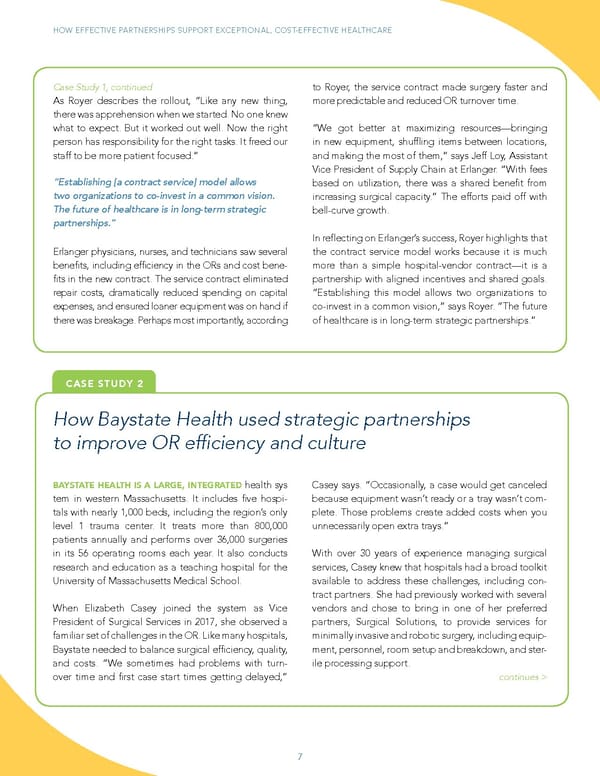HOW EFFECTIVE PARTNERSHIPS SUPPORT EXCEPTIONAL, COST-EFFECTIVE HEALTHCARE Case Study 1, continued to Royer, the service contract made surgery faster and As Royer describes the rollout, “Like any new thing, more predictable and reduced OR turnover time. there was apprehension when we started. No one knew what to expect. But it worked out well. Now the right “We got better at maximizing resources—bringing person has responsibility for the right tasks. It freed our in new equipment, shuffling items between locations, staff to be more patient focused.” and making the most of them,” says Jeff Loy, Assistant Vice President of Supply Chain at Erlanger. “With fees “Establishing [a contract service] model allows based on utilization, there was a shared benefit from two organizations to co-invest in a common vision. increasing surgical capacity.” The efforts paid off with The future of healthcare is in long-term strategic bell-curve growth. partnerships.” In reflecting on Erlanger’s success, Royer highlights that Erlanger physicians, nurses, and technicians saw several the contract service model works because it is much benefits, including efficiency in the ORs and cost bene- more than a simple hospital-vendor contract—it is a fits in the new contract. The service contract eliminated partnership with aligned incentives and shared goals. repair costs, dramatically reduced spending on capital “Establishing this model allows two organizations to expenses, and ensured loaner equipment was on hand if co-invest in a common vision,” says Royer. “The future there was breakage. Perhaps most importantly, according of healthcare is in long-term strategic partnerships.” CASE STUDY 2 How Baystate Health used strategic partnerships to improve OR efficiency and culture BAYSTATE HEALTH IS A LARGE, INTEGRATED health sys Casey says. “Occasionally, a case would get canceled tem in western Massachusetts. It includes five hospi- because equipment wasn’t ready or a tray wasn’t com- tals with nearly 1,000 beds, including the region’s only plete. Those problems create added costs when you level 1 trauma center. It treats more than 800,000 unnecessarily open extra trays.” patients annually and performs over 36,000 surgeries in its 56 operating rooms each year. It also conducts With over 30 years of experience managing surgical research and education as a teaching hospital for the services, Casey knew that hospitals had a broad toolkit University of Massachusetts Medical School. available to address these challenges, including con- tract partners. She had previously worked with several When Elizabeth Casey joined the system as Vice vendors and chose to bring in one of her preferred President of Surgical Services in 2017, she observed a partners, Surgical Solutions, to provide services for familiar set of challenges in the OR. Like many hospitals, minimally invasive and robotic surgery, including equip- Baystate needed to balance surgical efficiency, quality, ment, personnel, room setup and breakdown, and ster- and costs. “We sometimes had problems with turn- ile processing support. over time and first case start times getting delayed,” continues > 7
 Surgical Solutions White Paper Page 8 Page 10
Surgical Solutions White Paper Page 8 Page 10